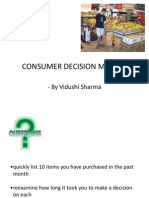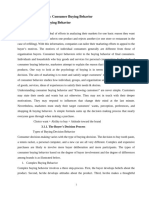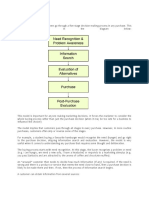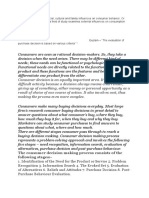Consumer Behavior Decision Process: What Is Decision Making
Uploaded by
gul_e_sabaConsumer Behavior Decision Process: What Is Decision Making
Uploaded by
gul_e_saba1
Consumer Behavior Decision Process
Introduction
Marketers need to understand the dynamics of the consumer
decision making process. While the process and the internal
and external factors affecting decision making would vary
from person to person and within the same person from
situation to situation, the study of consumer behavior
attempts to draw certain generalizations. The major decisions
taken by a consumer relate to what he buys (products and
services as also the brands), how much he buys (quantity),
where he buys (place), when he buys (time) and how he buys
(payment terms).
What is Decision Making
A decision is defined as choosing an option of the few/many available.
Decision making is the process of choosing between two or more alternatives;
It is the selection of an alternative out of the few/many choices that are
available.
Decision making is:
a) a goal oriented process.
b) it is a problem solving process: helps take advantage of opportunities and fight
threats.
Types of decision Making
Decisions Making can be of two types, a) Programmed decision
making, and, b) Non-programmed decision making.
a) Programmed decision making: This is applied for problems that
are routine and regular. Such problems are simple to deal with and
guidelines to sort out such problems exist. Such decisions are made
without much thought. With respect to marketing, these are decisions
related to day to day purchases or convenience and shopping goods;
these are generally low involvement purchases. They may also be
habitual in nature, and brand loyalty could easily develop. Examples:
Purchases made for staples, toiletries etc.
b) Non-programmed decision making: This is applied for problems
that arise suddenly and are unique or novel. As the problem is sudden
and novel, it is complex and requires a lot of information gathering,
deliberation and thought. With respect to marketing, these are
decisions related to infrequent purchases or specialty goods and
emergency goods; these are high involvement purchases.
Examples: Purchases made for laptops, real estate etc.
What is Consumer Decision Making
A consumer purchase is actually a response to a problem. Consumer Decision
Making pertains to making decisions regarding product and service offerings. It may
be defined as a process of gathering and processing information, evaluating it and
selecting the best possible option so as to solve a problem or make a buying choice.
Consumer Decision Making pertains to the following decisions:
a) What to buy: Products and Services (and the Brands?)
b) How much to buy: Quantity
c) Where to buy: Place
d) When to buy: Time
e) How to buy: Payment terms.
All purchase decisions are not similar. The effort put into each decision
making is different.
Steps In Decision Making Process
Need Recognition
Information Search
Evaluation of Alternatives
Purchase Decision
Post-Purchase Behavior
1. Need Recognition
When a person has an unsatisfied need, the buying process
begins to satisfy the needs. The need may be activated by internal
or external factors. The intensity of the want will indicate the speed
with which a person will move to fulfill the want. On the basis of
need and its urgency, the order of priority is decided. Marketers
should provide required information of selling points.
2. Information Search
Identified needs can be satisfied only when desired product
is known and also easily available. Different products are available
in the market, but consumer must know which product or brand
gives him maximum satisfaction. And the person has to search out
for relevant information of the product, brand or location.
Consumers can use many sources e.g., neighbors, friends and
family. Marketers also provide relevant information through
advertisements, retailers, dealers, packaging and sales promotion,
and window displaying. Mass media like news papers, radio, and
television provide information. Nowadays internet has become an
important and reliable source of information. Marketers are
expected to provide latest, reliable and adequate information.
3. Evaluation of Alternatives
This is a critical stage in the process of buying. Following
are important elements in the process of alternatives evaluation
a. A product is viewed as a bundle of attributes. These
attributes or features are used for evaluating products or
brands. For example, in washing machine consumer
considers price, capacity, technology, quality, model and
size.
b. Factors
like
company, brand
image,
country, and
distribution network and after-sales service also become
critical in evaluation.
c. Marketers should understand the importance of these
factors with regards to the consumers while manufacturing
and marketing their products.
4. Purchase Decision
Outcome of the evaluation develops likes and dislikes about alternative products or
brands in consumers. This attitude towards the brand influences a decision as to buy
or not to buy. Thus the prospective buyer heads towards final selection. In addition to
all the above factors, situational factors like finance options, dealer terms, falling
prices etc., are also considered.
5. Post- Purchase Behavior
Post-purchase behavior of consumer is more important as far as marketer is
concerned. Consumer gets brand preference only when that brand lives up to his
expectation. This brand preference naturally repeats sales of marketer. A satisfied
buyer is a silent advertisement. But, if the used brand does not yield desired
satisfaction, negative feeling will occur and that will lead to the formation of negative
attitude towards brand. This phenomenon is called cognitive dissonance. Marketers
try to use this phenomenon to attract users of other brands to their brands. Different
promotional-mix elements can help marketers to retain his customers as well as to
attract new customers.
LEVELS OF DECISION MAKING
While decision making is defined as the selection of an alternative to solve a problem,
the time and effort required to complete the process varies across buying situations.
We may define three kinds problem solving spread over a continuum; these are
referred to as the levels of consumer decision making;
(i) Extensive problem solving (EPS)
(ii) Limited problem solving (LPS)
(iii) Reutilized problem solving (RPS) or reutilized response behavior. These are
explained as follows:
a) Extensive problem solving (EPS): In EPS, the consumer is unfamiliar with
the product/service category; he is not informed of the product or service offering,
and thus, the situation requires extensive information search and evaluation.
The consumer is not aware:
- about the various decision criteria used to evaluate the product or service offering. of the various brands that are available and from which to evaluate.
The result is that the purchase process involves significant effort on part of the
consumer. He has to gather knowledge about (i) the decision criteria; (ii) the brands
available; and (iii) make a choice amongst the brands.
The types of products and / situations where we generally have EPS:
1. These goods are ones of high involvement; they are expensive; they
are infrequently bought; there is considerable amount of risk
involved.
2. These are generally first time purchases
Examples: Jewellery, electronic goods, Real estate and property etc.
b) Limited problem solving (LPS): The consumer is familiar of the product or
service offering; but he is unaware of the various brands. The case is one where the
buyer is familiar with the product category but unfamiliar with the brands.
The consumer:
-
is aware of some brands and also of the various criteria used to evaluate the
product or service offering.
- is unaware of the new brands that have been introduced.
-
has not evaluated the brands amongst the awareness set and has not
established preferences amongst the group of brands.
The result is that the purchase process is more of a recurring purchase and it
involves only a moderate effort on part of the consumer. He has to gather knowledge
to add/modify the existing knowledge that he has in his memory. Thereafter he has to
make a decision.
The types of products and / situations where we generally have LPS:
1. These goods are ones of low involvement; they are generally moderately
priced; they are frequently bought; there is lesser amount of risk involved.
2. These are generally recurring purchases.
Exceptions:
They may also be cases where an expensive product is being
repurchased. Examples: A laptop replacing a desktop, a second TV for
the home.
c) Routinized problem solving (RPS) or routinized response behavior:
The consumer is well informed and experienced with the product or service offering.
The consumer is aware of both the decision criteria as well as the various brands
available.
Here, the goods are ones of low involvement; they are inexpensive; they are
frequently bought; there is no risk involved. These are routine purchases and are a
direct repetition, where the consumer may be brand loyal.
The result is that the purchase process involves no effort on part of the
consumer. It is simple and the process is completed quickly; purchases are routine and
made out of habit.
The types of products and / situations where we generally have RPS:
1. These goods are ones of low involvement; they are inexpensive; they
are frequently bought; there is no risk involved.
2. These are routine purchases and the consumer is brand
loyal. Examples: Staples, Cold drinks, Stationery etc.
BUYING ROLES
Consumer decision making is a complex process. It is interplay of reactions amongst
a consumer and his cognition, affect and behavior on the one hand, as well as the
environmental forces on the other hand.
The actual transaction/ exchange are preceded by considerable amount of
thought processes and influences. This could be explained in terms of the five
Buying Roles viz., Initiator, Influencer, Decider, Buyer and, User. The marketer
needs to understand these roles so as to be able to frame suitable strategies to target
them.
a) Initiator: The person who identifies a need and first suggests the idea of buying a
particular product or service.
b) Influencer: The person(s) who influences the buyer in making his final choice of the
product.
c) Decider: The person who decides on the final choice: what is to be bought, when,
from where and how?
d) Buyer: The person who enters into the final transaction and exchange process or is
involved in the physical activity of making a purchase.
e) User: The person(s) who actually consumes the product or service offering.
The various buying roles can be illustrated through examples:
Example: 1
A kindergarten girl needs to buy color crayons to use in class.
10
i) Initiator: The girl
ii) Influencer: Her teacher or her classmates
iii) Decider: Either of the parents
iv) Buyer: Either of the parents or a sibling.
v) User: The girl herself.
Example 2:
The mother of the house is a housewife; she loves watching TV when her husband
and children go for work. She has been complaining that the present TV set at home
has been giving problem. She also says that the model is now an old one and that that
the family should own a new model.
d. Initiator: The lady
e. Influencer: Her neighbors and friends.
f. Decider: Joint: Her husband, she herself and the children.
g. Buyer: Husband or son or daughter or she herself.
h. User: The family.
Example 3:
A boy enters college and needs a laptop for doing assignments.
1. Initiator: The boy himself
2. Influencer: His friends and classmates.
11
3. Decider: The boy himself.
4. Buyer: The boy himself.
5. User: The boy himself.
Note:
- These five roles may be performed by one person or many persons.
- A person may perform more than one role.
-
The role(s) that one assumes for a particular product purchase and in a
particular purchase situation may differ to another product purchase
and in another purchase situation.
It is even more noteworthy that:
As far as Buyer Behavior is concerned, the buyers role is the most important; it is he
who enters into a transaction and final exchange.
-
actual and final decision is always made at the time of transaction by the
buyer. - the decider may make a choice, but the exchange is entered into by the
buyer
Consumer Decision Rules
These are generally referred to as information processing strategies. These are
procedures that help consumers to evaluate various options and reduce the risk of
12
making complex decisions by providing the guidelines. Decision rules have been
broadly classified into two categories:
Compensatory Decision Rules: Consumers evaluate brand or model in terms of each
attribute and computes a weighted score for each brand. The computed score reflects
the brands relative merit as a potential purchase choice. The assumption is that
consumer will select the brand that scores highest among alternative brands. The
unique feature of this rule is that it balances the positive evaluation of a brand on one
attribute to balance out a negative evaluation on some other attribute. For example,
positive attribute like high fuel efficiency is balanced with the negative evaluation of
high maintenance cost.
2.Non-compensatory Decision Rules: In contrast to the above
rule non-compensatory rules do not allow consumers to balance
positive evaluation of a brand on one attribute against negative
evaluation on some other attribute. There are three types of
non-compensatory rules.
Conjunctive Decision Rule: In conjunctive decision rule the
consumer establishes a different, minimally acceptable level as a
cut off point for each attribute. In this the option is eliminated for
further consideration if a specific brand or model falls below the
cutoff point on any attribute.
Disjunctive Rule: It is the mirror image of conjunctive rule. Here
the consumer establishes a separate minimally acceptable cut off
level for each attribute. In this case if an option meets or exceeds
the cut off established for any one attribute, it is accepted.
Lexicographic Decision Rule: In this rule the consumer initially
ranks the attributes in terms of perceived relevance or importance.
Later he compares different alternatives in terms of the single
attribute that is considered most important. On this top ranked
13
alternative, regardless of the score on any other attribute, if one
option scores sufficiently high it is selected and the process ends.
References:
***Module
4:
Consumer
Behavior,
Sangeeta
Sahney
Assistant Professor,Vinod Gupta School of ManagementIndian
Institute of TechnologyKharagpur, India
*** Consumer Behavior Notes for MBA, Pondicheery
University,India
14
THANK YOU
You might also like
- The Consumer Decision Making Process: Chapter-4No ratings yetThe Consumer Decision Making Process: Chapter-423 pages
- Module 4: The Consumer Decision Making Process Lesson - 7No ratings yetModule 4: The Consumer Decision Making Process Lesson - 79 pages
- Supplementary Slides Consumer Decision MakingNo ratings yetSupplementary Slides Consumer Decision Making53 pages
- Consumer Decision Making: Individual Buying Decision ProcessNo ratings yetConsumer Decision Making: Individual Buying Decision Process83 pages
- Chapter 4: Consumer Decision-Making ProcessNo ratings yetChapter 4: Consumer Decision-Making Process25 pages
- E-Note 14811 Content Document 20240103110324AMNo ratings yetE-Note 14811 Content Document 20240103110324AM34 pages
- By DR - Genet Gebre: 5. Consumer Decision Making Process (Mbam 641)No ratings yetBy DR - Genet Gebre: 5. Consumer Decision Making Process (Mbam 641)32 pages
- Lesson Note PPT Consumer Behavior 2023 DNo ratings yetLesson Note PPT Consumer Behavior 2023 D37 pages
- Consumer Buying Behavior: Taruna D BangaNo ratings yetConsumer Buying Behavior: Taruna D Banga13 pages
- Chapter II. 2Consumer Decision Making EditedNo ratings yetChapter II. 2Consumer Decision Making Edited23 pages
- Consumer Decision Making: - by Vidushi SharmaNo ratings yetConsumer Decision Making: - by Vidushi Sharma35 pages
- Consumer Decision Making Process (Reference)No ratings yetConsumer Decision Making Process (Reference)9 pages
- Consumer Behaviour and Rural Marketing AssignmentNo ratings yetConsumer Behaviour and Rural Marketing Assignment15 pages
- Complex Buying Behavior Final Notes Doc NNo ratings yetComplex Buying Behavior Final Notes Doc N37 pages
- CB Module 2 (Consumer Decionmaking Process)No ratings yetCB Module 2 (Consumer Decionmaking Process)29 pages
- The Consumer Decision Making Process Consists of The Following StagesNo ratings yetThe Consumer Decision Making Process Consists of The Following Stages29 pages
- BMKT209 Selling and Sales Management Question 1 Assignment 1No ratings yetBMKT209 Selling and Sales Management Question 1 Assignment 19 pages
- Consumer Behavior - You Are What You BuyNo ratings yetConsumer Behavior - You Are What You Buy31 pages
- MKT 302 - Types of Decision Making Report.No ratings yetMKT 302 - Types of Decision Making Report.16 pages
- ABC324 Advertising and The Consumer BehaviorNo ratings yetABC324 Advertising and The Consumer Behavior4 pages
- Consumerdecisionmakingandbeyond 110214023948 Phpapp01No ratings yetConsumerdecisionmakingandbeyond 110214023948 Phpapp0118 pages
- Consumer Decision Making and Diffusion of Innovation-SummaryNo ratings yetConsumer Decision Making and Diffusion of Innovation-Summary2 pages
- The Changing Global Marketplace Landscape: Understanding Customer Intentions, Attitudes, Beliefs, and FeelingsFrom EverandThe Changing Global Marketplace Landscape: Understanding Customer Intentions, Attitudes, Beliefs, and FeelingsNo ratings yet
- Dlis105 Reference Sources and Services PDFNo ratings yetDlis105 Reference Sources and Services PDF163 pages
- RDA Refresher Performance Support: What Is Different From AACR2?No ratings yetRDA Refresher Performance Support: What Is Different From AACR2?7 pages
- Dlis108 Information and Communication Technology Applications100% (1)Dlis108 Information and Communication Technology Applications150 pages
- Access To Electronic Information Resources in Libraries: Dr. N. Rupsing NaikNo ratings yetAccess To Electronic Information Resources in Libraries: Dr. N. Rupsing Naik24 pages
- Mudarabah Islamic Mode of Financing Lecture NotesNo ratings yetMudarabah Islamic Mode of Financing Lecture Notes4 pages
- Use of Cd-Rom Databases: A Case Study: January 2018No ratings yetUse of Cd-Rom Databases: A Case Study: January 20189 pages
- Murabahafinalpresentationsonia1 1 160417092910No ratings yetMurabahafinalpresentationsonia1 1 16041709291043 pages
- Murabaha Finance by Muhammad Tayyab RazaNo ratings yetMurabaha Finance by Muhammad Tayyab Raza58 pages
- Principles of Marketing CLEP Quick Prep SheetFrom EverandPrinciples of Marketing CLEP Quick Prep Sheet
- Module 4: The Consumer Decision Making Process Lesson - 7Module 4: The Consumer Decision Making Process Lesson - 7
- Consumer Decision Making: Individual Buying Decision ProcessConsumer Decision Making: Individual Buying Decision Process
- By DR - Genet Gebre: 5. Consumer Decision Making Process (Mbam 641)By DR - Genet Gebre: 5. Consumer Decision Making Process (Mbam 641)
- The Consumer Decision Making Process Consists of The Following StagesThe Consumer Decision Making Process Consists of The Following Stages
- BMKT209 Selling and Sales Management Question 1 Assignment 1BMKT209 Selling and Sales Management Question 1 Assignment 1
- Consumerdecisionmakingandbeyond 110214023948 Phpapp01Consumerdecisionmakingandbeyond 110214023948 Phpapp01
- Consumer Decision Making and Diffusion of Innovation-SummaryConsumer Decision Making and Diffusion of Innovation-Summary
- A Consumer’s Guide to Successfully Resolving Any DisputeFrom EverandA Consumer’s Guide to Successfully Resolving Any Dispute
- The Changing Global Marketplace Landscape: Understanding Customer Intentions, Attitudes, Beliefs, and FeelingsFrom EverandThe Changing Global Marketplace Landscape: Understanding Customer Intentions, Attitudes, Beliefs, and Feelings
- RDA Refresher Performance Support: What Is Different From AACR2?RDA Refresher Performance Support: What Is Different From AACR2?
- Dlis108 Information and Communication Technology ApplicationsDlis108 Information and Communication Technology Applications
- Access To Electronic Information Resources in Libraries: Dr. N. Rupsing NaikAccess To Electronic Information Resources in Libraries: Dr. N. Rupsing Naik
- Use of Cd-Rom Databases: A Case Study: January 2018Use of Cd-Rom Databases: A Case Study: January 2018













































































